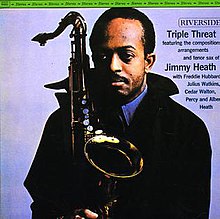music.wikisort.org - Composition
Triple Threat is the fourth album by saxophonist Jimmy Heath featuring performances recorded in 1962 originally released on the Riverside label.[1]
| Triple Threat | ||||
|---|---|---|---|---|
 | ||||
| Studio album by Jimmy Heath | ||||
| Released | 1962 | |||
| Recorded | January 4 & 7, 1962 New York City | |||
| Genre | Jazz | |||
| Length | 37:09 | |||
| Label | Riverside RLP 400 | |||
| Jimmy Heath chronology | ||||
| ||||
Recording
Triple Threat was a follow-up of Heath's 1961 album The Quota and used the same band.[2][3] The Penguin Guide to Jazz Recordings considers the line-up, which features Heath's brothers Percy and Albert, a "dry-run" for their later Heath Brothers records.[4] The album was recorded over two sessions in January 1962. Freddie Hubbard and Julius Watkins were not present for the second session when "The More I See You" was recorded.[5]
The song "Gemini" was written for Heath's daughter, Roslyn, whose star sign it was.[2]
The album title was an allusion to Heath's own status as a "triple threat": musician, arranger and composer.[6] In the album liner notes, Ira Gitler described Heath in the following way:
The triple threat in football must pass, punt, and run on a high level. Musically, Jimmy Heath approximates this by his composing, arranging and playing, all of which are ably and amply demonstrated here.[7]
Release and reception
| Review scores | |
|---|---|
| Source | Rating |
| Allmusic | |
| The Penguin Guide to Jazz Recordings | |
Cannonball Adderley recorded his own version of "Gemini" only 10 days after Heath's recording.[6] Shortly beforeTriple Threat was released in 1962, Adderly released a record featuring his version which somewhat overshadowed Heath's recording.[9]
Scott Yanow of Allmusic says, "The arrangements of Heath uplift the straightahead music and make each selection seem a bit special".[8] Billboard described the album as one of Heath's best sessions, praising his playing and the "directness, individuality and strength" of the compositions.[10]
In his autobiography, Heath, a Philadelphian, recalls his pride that he was gaining recognition in his hometown upon reading a positive review of the album in the Philadelphia Daily News.[2]
Track listing
All compositions by Jimmy Heath except as indicated
- "Gemini" - 6:09
- "Bruh Slim" - 5:16
- "Goodbye" (Gordon Jenkins) - 7:04
- "Dew and Mud" - 5:01
- "Make Someone Happy" (Jule Styne, Betty Comden, Adolph Green) - 3:41
- "The More I See You" (Harry Warren, Mack Gordon) - 4:18
- "Prospecting" - 5:40
Personnel
- Jimmy Heath - tenor saxophone
- Freddie Hubbard - trumpet
- Julius Watkins - French horn
- Cedar Walton - piano
- Percy Heath - bass
- Albert Heath - drums
References
- Riverside Records discography accessed October 23, 2012
- Heath, Jimmy (2010). I walked with giants : the autobiography of Jimmy Heath. Joseph McLaren. Philadelphia: Temple University Press. pp. 123–124. ISBN 978-1-4399-0200-4. OCLC 701719409.
- Yanow, Scott (2000). Bebop. San Francisco: Miller Freeman Books. pp. 116–117. ISBN 978-0-87930-608-3.
- Cook, Richard; Morton, Brian (2008). The Penguin Guide to Jazz Recordings (9th ed.). Penguin. p. 679. ISBN 978-0-141-03401-0.
- Cherrington, George (1963). Jazz catalogue 1963. The Archive of Contemporary Music. London: Jazz Journal LTD. p. 86.
- Ullman, M. (May 2020). "The jazz column". Fanfare. 43: 528–535.
- Ira Gitler, liner notes for Jimmy Heath, Triple Threat (1962), LP, Riverside Records RPL-9400
- Yanow, S. Allmusic Review accessed October 23, 2012
- Nelson, Nels (25 July 1962). "Jimmy Heath, It's Connections, Not Work". Philadelphia Daily News. p. 39.
- Billboard. 1962-04-21. p. 39.
Другой контент может иметь иную лицензию. Перед использованием материалов сайта WikiSort.org внимательно изучите правила лицензирования конкретных элементов наполнения сайта.
WikiSort.org - проект по пересортировке и дополнению контента Википедии